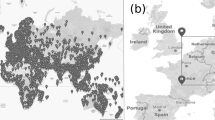Abstract
It is generally recognized that the current routing scheme of Internet suffers from serious scalability problems. In this paper, we work with the abstract but ‘Internet-like’ network model consisting of an infinite-variance power-law random graph (IVPLRG). We adopt the idea of a routing scheme proposed by Carmi, Cohen and Dolev (C-C-D). The scheme fits very naturally to the spontaneously emerging ‘soft hierarchy’ architecture on an IVPLRG. The use of multiple addresses is suggested as a solution to the inflexibility of the pure C-C-D scheme. A mean-field approximation is introduced for efficient computation of relevant quantitative characteristics and applied to various problems of our scheme. We review a few recent Internet routing proposals and discuss their relation to our scheme. We find out that the topology creation of our scheme offers advantages in terms of scalability and routing policy control.
Similar content being viewed by others
References
Brady, A., & Cowen, L. (2006). Compact routing on power-law graphs with additive stretch. In ALENEX.
Carmi, S., Cohen, R., & Dolev, D. (2006). Searching complex networks efficiently with minimal information. Europhysics Letters, 74(6), 1102–1108.
Chung, F., & Lu, L. (2003). The average distance in a random graph with given expected degrees. Internet Mathematics, 1(1), 91–113.
Cowen, L. (2001). Compact routing with minimum stretch. Journal of Algorithms, 38(1), 170–183.
Farinacci, D., Fuller, V., & Meyer, D. (2009). Locator/ID separation protocol (LISP). http://tools.ietf.org/html/draft-ietf-lisp-04. Internet Draft, September 16, 2009.
Farinacci, D., Fuller, V., Meyer, D., & Lewis, D. (2009). LISP alternative topology (LISP + ALT). draft-ietf-lisp-alt-05.txt. Internet Draft, February 24, 2009.
Godfrey, P., Ganichev, I., Shenker, S., & Stoica, I. (2009). Pathlet routing. In SIGCOMM’09, Barcelona, Spain, August 2009.
Janson, S., Łuczak, T., & Norros, I. (2009, submitted). Large cliques in a power-law random graph. arXiv:0905.0561.
Krioukov, D., Fall, K., & Yang, X. (2004). Compact routing on Internet-like graphs. In Infocom. doi:10.1109/INFCOM.2004.1354495.
Krioukov, D., Claffy, K. C., Fall, K., & Brady, A. (2007). On compact routing for the Internet. ACM SIGCOMM Computer Communication Review (CCR), 37(3), 41–52.
Norros, I. (2009). Powernet: compact routing on Internet-like random networks. In NGI 2009, Aveiro, July 2009.
Norros, I., & Reittu, H. (2006). On a conditionally Poissonian graph process. Advances in Applied Probability, 38, 59–75.
Norros, I., & Reittu, H. (2008). Network models with a ‘soft hierarchy’: a random graph construction with loglog scalability. IEEE Network, 22(2), 40–46.
Norros, I., & Reittu, H. (2008). On the attack resistance of power-law random graphs in the finite mean, infinite variance region. Internet Mathematics, 5(3), 251–266.
Reittu, H., & Norros, I. (2002). On the effect of very large nodes in Internet graphs. In Proc. GLOBECOM, Taipei, Taiwan.
Yang, X., Clark, D., & Berger, A. (2007). NIRA: a new inter-domain routing architecture. IEEE/ACM Transactions on Networking, 15(4), 775–788.
Author information
Authors and Affiliations
Corresponding author
Rights and permissions
About this article
Cite this article
Norros, I., Flinck, H. Powering Internet with power-law networking. Telecommun Syst 48, 63–75 (2011). https://doi.org/10.1007/s11235-010-9334-y
Published:
Issue Date:
DOI: https://doi.org/10.1007/s11235-010-9334-y




